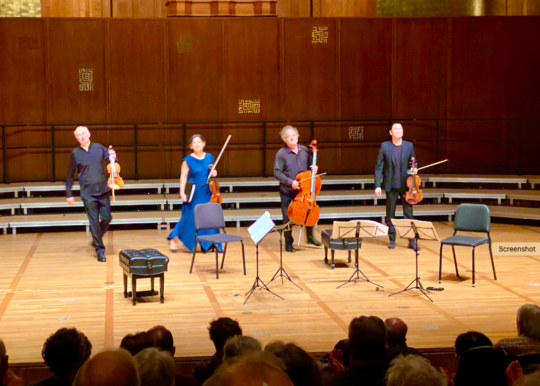 United States Haydn, Britten, Beethoven: Takács Quartet (Edward Dusinberre, Harumi Rhodes [violins], Richard O’Neill [viola], András Fejér [cello]). Cal Performances, Hertz Hall, University of California Berkeley, 16.2.2025. (HS)
United States Haydn, Britten, Beethoven: Takács Quartet (Edward Dusinberre, Harumi Rhodes [violins], Richard O’Neill [viola], András Fejér [cello]). Cal Performances, Hertz Hall, University of California Berkeley, 16.2.2025. (HS)

Haydn – String Quartet in C major, Op.54 No.2
Britten – String Quartet No.2 in C major, Op.36
Beethoven – String Quartet in F major, Op.59 No.1, ‘Razumovsky’
The Takács Quartet, now in its fiftieth-anniversary season, was founded in Budapest but has been based in Boulder, Colorado, since 1983. They delivered a sparkling lineup of Haydn, Britten and Beethoven string quartets on Sunday afternoon at the University of California Berkeley. Beyond their precision and their carefully molded, unified phrasing was something extra — a sense of excitement, almost elation, that permeated all three pieces.
A though line to the program was how each of the quartets reflected their composers’ quests for surprise. That is a calling card for Haydn, whose Op.54 No.2 came through as a delightful series of musical twists and turns. In its time, Beethoven’s Op.59 No.1 (the first of the ‘Razumovsky’ quartets) stretched the boundaries of the string quartet genre at forty minutes, during which the composer’s sense of discovery never flags.
Those two works would be familiar to casual classical fans, but Britten’s Quartet in C major is played less often, and it made the biggest impact in this program. The finale, an extended chaconne, is often extracted as a stand-alone. It was first performed in 1945, on the 250th anniversary of Henry Purcell’s death. The most obvious reference to that seventeenth-century composer is the finale, titled Chacony, a spelling Purcell used.
In Britten’s distinctive, edgy style, the movement develops into something more than a series of twenty-one variations on a somber theme. Other than the advanced harmonies, there are three extensive cadenzas — first for cello, then viola and, finally, first violin. That innovation can lift the fourteen-minute finale into another realm, and indeed did so in this go-round.
Cellist András Fejér, the only remaining member of the original Takács Quartet, interrupted the solemn flow of the first six variations with a flair that properly anticipated the rising mood of the second series of six. Violist Richard O’Neill, the newest member (who joined the quartet only five years ago), elaborated eloquently in his cadenza, pointing to the rhythmic emphasis in the next series. First violinist Edward Dusinberre raised the stakes with his soaring cadenza, setting up the final three, and their broadly hymn-like climax.
If anyone needed signs of what this music was about, all they had to do was focus on second violinist Harumi Rhodes. She may not have had a cadenza in Britten’s quartet, but her expressive face, body language and, most of all, playing felt like the fulcrum to much of the music. When the rhythm of the first movement kicked in, she was rocking in her chair to the beat. Her eyes darted among the other musicians to time her part in the deft dance of the second movement.
Her attention to the details around her was also evident in the Haydn and Beethoven. No doubt it helped corral the tricky opening to the Haydn, in which gestures flit among the entire quartet, and pulled together the wanderings in the lengthy Beethoven quartet that concluded the afternoon. When Rhodes took the baton on phrases that relayed around the musicians, she made it fit, often just different enough to make her contribution distinct.
The Haydn kicked things off with brightness and a bit of spiciness to the quick-paced inflections of the opening movement. There is a reason string quartets like to open concerts with Haydn, who pretty much invented the genre’s style in the late eighteenth century. They are melodic, rhythmic, and the composer loved to tuck surprising harmonies into the flow. This performance relished the way the opening false-starts two or three times before it gets going, and in a different key.
In the Adagio that followed, Dusinberre’s obbligato sang beautifully, its melody traveling over several octaves against soft chords from the other instruments. I liked the way the occasional dissonances in the Minuet were not emphasized, and then how the short Presto section interrupted the calm musings of the Adagio finale, almost like a footnote before finishing lightly.
A highlight of the Beethoven was the unexpected little fugue that plays on the happy tune in the first movement, developing into a richness before coming to rest. The lively scherzo that followed, with its elbow-in-the-ribs accents (that, for me, called Haydn’s style to mind), contrasted with the sober Adagio that came next. The pace on that was perfect and allowed the rich harmonies to flow smoothly.
The musicians kept the sunlight bright in the finale, with every recurrence of its lively, Russian-folk-dance tune drawing a smile. The slowdown near the end nicely mirrored the unexpected speed-up of the Haydn finale, and it all ended with a welcome bounce.
Harvey Steiman
